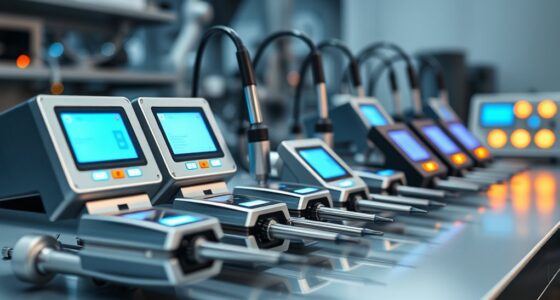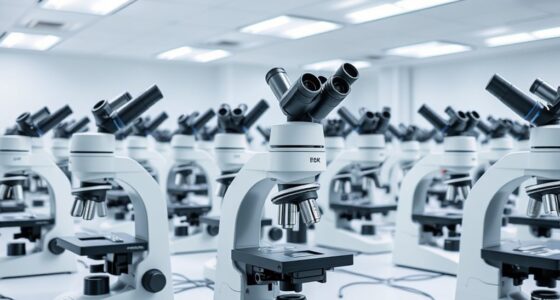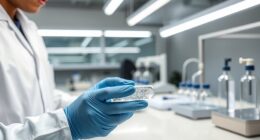If you’re exploring the 14 best gel electrophoresis systems for 2025, I can help. These systems combine precision, safety, and efficiency with features like leak-proof tanks, adjustable levels, LED visualization, and high transfer efficiency. They support high-throughput, small-scale, and cost-effective lab setups. Whether you need horizontal or vertical models, the options focus on durability, easy maintenance, and reliable results. Keep going, and you’ll discover detailed info to help you choose the right system for your needs.
Key Takeaways
- Prioritize systems with durable, leak-proof polycarbonate tanks and advanced heat dissipation for consistent, precise results.
- Choose models offering high throughput capabilities, such as multi-gel support and adjustable voltage controls.
- Opt for systems featuring safe, UV-free visualization methods like blue LED transilluminators and fluorescent dye compatibility.
- Consider compact, portable designs ideal for educational and small lab environments without compromising performance.
- Evaluate ease of maintenance with detachable electrodes, quick blotting, and compatibility with common buffers like TBE and TAE.
Horizontal Electrophoresis Tank for DNA and Nucleic Acid Purification
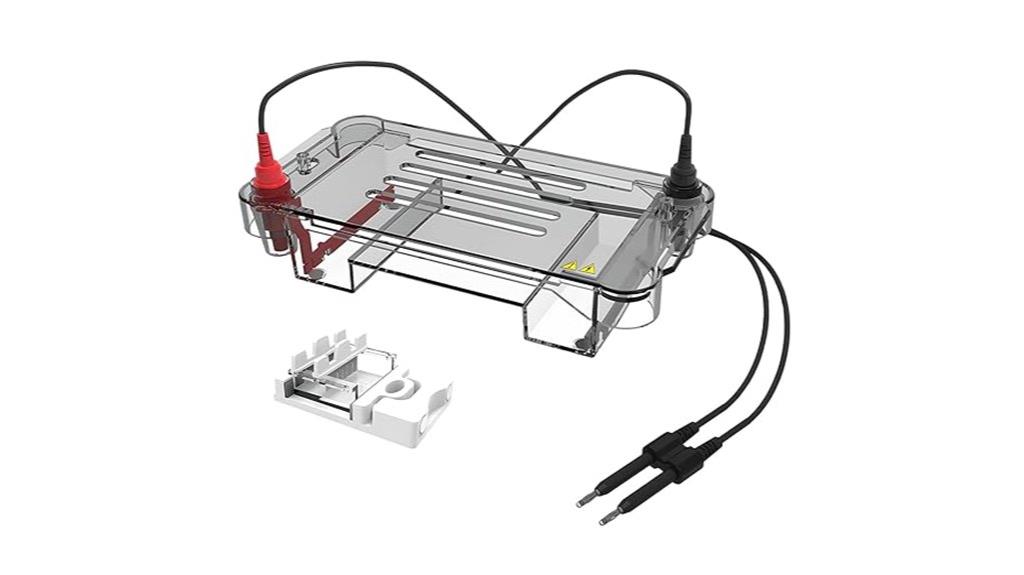
If you’re looking for a reliable tool for DNA and nucleic acid purification, the Horizontal Electrophoresis Tank is an excellent choice. Its 60×75mm gel size and 300mL buffer capacity make it ideal for lab applications like separation, identification, and preparation. Crafted from durable polycarbonate with injection molding, it’s built to last and prevent leaks. The innovative heat dissipation system maintains stable conditions, while the detachable platinum electrodes ensure excellent conductivity and easy replacement. Plus, the gel preparation is straightforward with the telescopic elastic glue maker, making your workflow cleaner and more efficient. This tank offers reliable performance tailored for precise DNA analysis.
Best For: researchers and laboratory technicians seeking a durable, efficient, and reliable tool for DNA and nucleic acid purification, separation, and analysis.
Pros:
- Made from durable polycarbonate with injection molding for long-lasting use and leak-proof performance
- Features an innovative heat dissipation system to maintain stable working conditions during electrophoresis
- Equipped with detachable platinum electrodes for excellent conductivity and easy maintenance
Cons:
- Limited gel size (60×75mm), which may not suit large-scale or high-throughput applications
- Requires careful handling of electrodes during replacement to prevent damage
- May have a learning curve for users unfamiliar with electrophoresis equipment setup
PLEXUS MegaX®

For those seeking a supplement that supports heart, brain, and skin health, PLEXUS MegaX® stands out due to its broad spectrum of plant-based Omega fatty acids. It promotes healthy lipid levels, enhances overall wellness, and benefits hair, skin, and nails. Many users report better sleep when taking two soft gels before bed, though some experience grogginess. Its key ingredients include highly bioavailable Omega-3s from ahiflower oil, punicic acid-rich pomegranate seed oil, and oleic acid from avocado oil. Formulated with sustainably sourced, contaminant-free ingredients, PLEXUS MegaX® offers an easy-to-swallow soft gel that supports cardiovascular and neurological health.
Best For: individuals seeking a plant-based Omega supplement to support heart, brain, skin health, and overall wellness, especially those interested in sustainable, contaminant-free ingredients.
Pros:
- Contains highly bioavailable Omega-3s from ahiflower oil, supporting cardiovascular and neurological health
- Includes beneficial fatty acids like punicic acid and oleic acid, promoting skin, hair, and nail health
- Formulated with sustainably sourced, contaminant-free ingredients and easy-to-swallow soft gels
Cons:
- May be expensive compared to other Omega supplements
- Some users report experiencing grogginess or drowsiness when taking before bedtime
- Not suitable for individuals with fish allergies or specific dietary restrictions needing fish-based Omega sources
Electrophoresis System for Agarose Gels, with LED
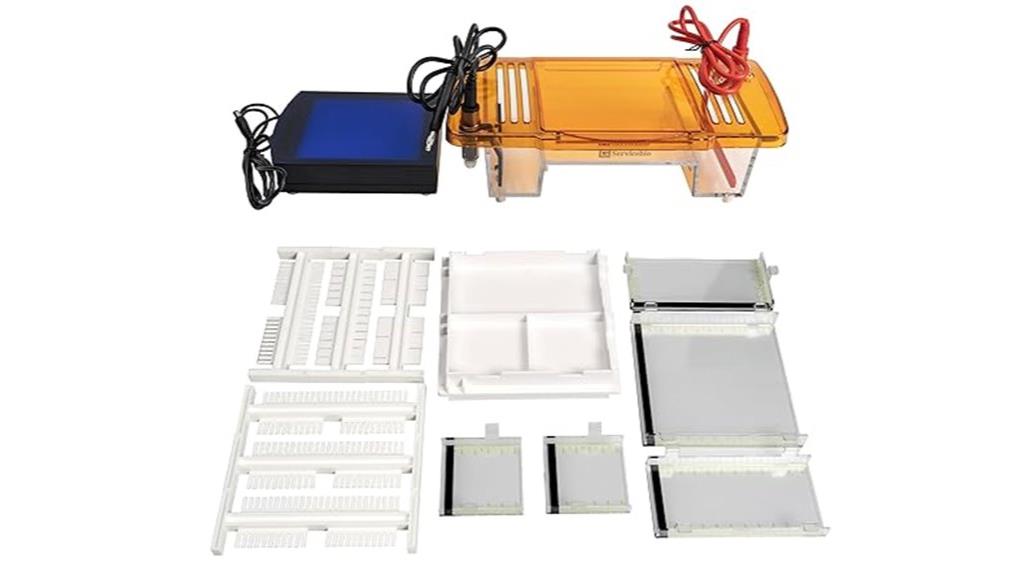
The Electrophoresis System for Agarose Gels with LED (Product Number: SVL-2) is ideal for laboratories seeking a safe and efficient way to visualize nucleic acids during electrophoresis. It features a blue LED transilluminator at 470nm, allowing direct observation of DNA and RNA bands without UV exposure. Its compact design measures 310mm by 150mm by 120mm and weighs about 1kg, making it portable and easy to handle. The system includes gel molds and trays for four different gel sizes, offering versatility. With detachable components and a 260mL buffer capacity, it’s user-friendly and suitable for various lab applications.
Best For: laboratories and researchers seeking a safe, efficient, and versatile system for DNA and RNA visualization during electrophoresis without UV exposure.
Pros:
- Safe blue LED illumination eliminates the need for UV exposure, reducing health risks.
- Compact and lightweight design enhances portability and ease of use in various lab settings.
- Includes multiple gel molds and trays for different gel sizes, offering versatility for different experiments.
Cons:
- Limited to agarose gel electrophoresis, may not be suitable for other gel types or electrophoresis methods.
- Buffer capacity of 260mL might require frequent refilling for high-throughput applications.
- The system’s size and features may not accommodate very large gel formats or specialized electrophoresis needs.
Gel Transfer Electrophoresis System (Up to 4 Gels)

The Gel Transfer Electrophoresis System is ideal for laboratories that need to process multiple membranes simultaneously with efficiency. It supports up to four gels, allowing me to blot four membranes at once or fewer, streamlining workflows. The dual-plate design is compatible with the BVE-4 electrophoresis system, and the high-transparency, corrosion-resistant polycarbonate tank provides durability and clear visibility. The transfer clip, marked for positive and negative poles, makes operation straightforward. With a typical blotting time of 20–40 minutes, it offers high efficiency, and its structural stability enables concurrent ice bath cooling, preventing overheating and ensuring reliable, reproducible results.
Best For: laboratories requiring efficient, simultaneous protein transfer of up to four membranes with high visibility and durability.
Pros:
- Supports up to four gels/membranes simultaneously, enhancing workflow efficiency
- Durable, corrosion-resistant polycarbonate construction ensures longevity and clear visibility
- Quick blotting time of 20–40 minutes with stable structural design for reliable results
Cons:
- Limited to a maximum of four membranes, which may not suit very large-scale processing needs
- May require compatible electrophoresis systems (like BVE-4) for optimal use
- Slightly larger footprint due to dual-plate design could be less suitable for compact lab spaces
Parco Scientific Electrophoresis Apparatus
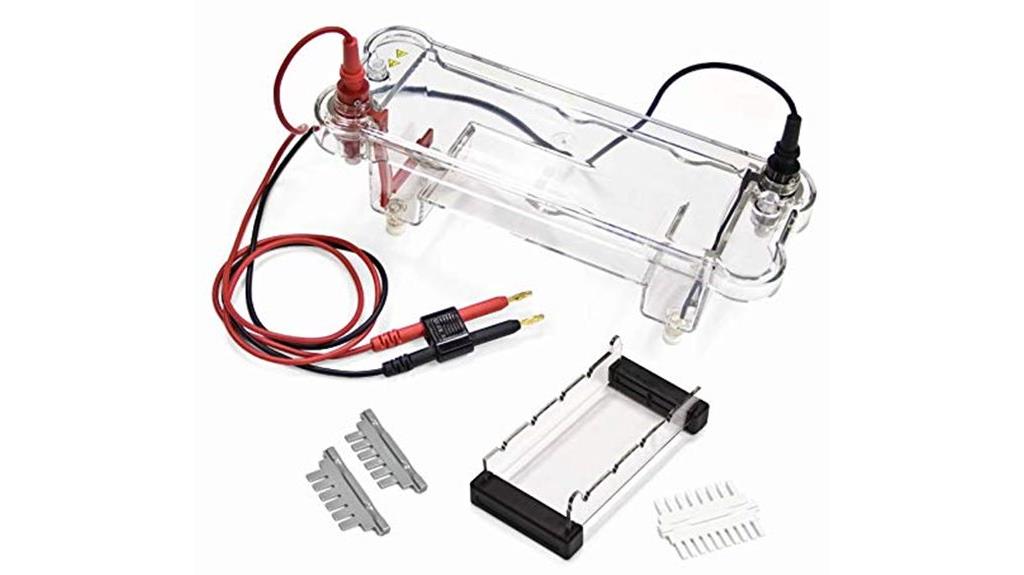
Looking for a reliable electrophoresis system that prioritizes safety and ease of use? The Parco Scientific Electrophoresis Apparatus fits the bill perfectly. Its durable, leak-proof acrylic chamber and removable lid make setup straightforward and safe. The electrodes lock securely, preventing incorrect connections, while recessed wires keep everything neat. Adjustable leveling feet ensure stability on uneven surfaces. Designed to run 16 samples simultaneously, it offers versatile gel setup with multiple comb options. Compact and lightweight at just 2 pounds, it’s easy to transport. Overall, the Parco Scientific system combines safety, convenience, and efficiency, making it an excellent choice for precise gel electrophoresis.
Best For: researchers and laboratories seeking a safe, reliable, and easy-to-use electrophoresis system for simultaneous analysis of multiple samples.
Pros:
- Durable, leak-proof acrylic chamber with UV transparency for safe visualization
- Secure electrode locking and recessed wiring enhance safety and neatness
- Compact, lightweight design for easy transport and setup
Cons:
- Requires a compatible power supply for operation
- Limited to 16 sample capacity per gel, which may not suit very high-throughput needs
- May need additional accessories like buffers and combs for complete setup
Horizontal Electrophoresis Tank for DNA and Nucleic Acid Purification
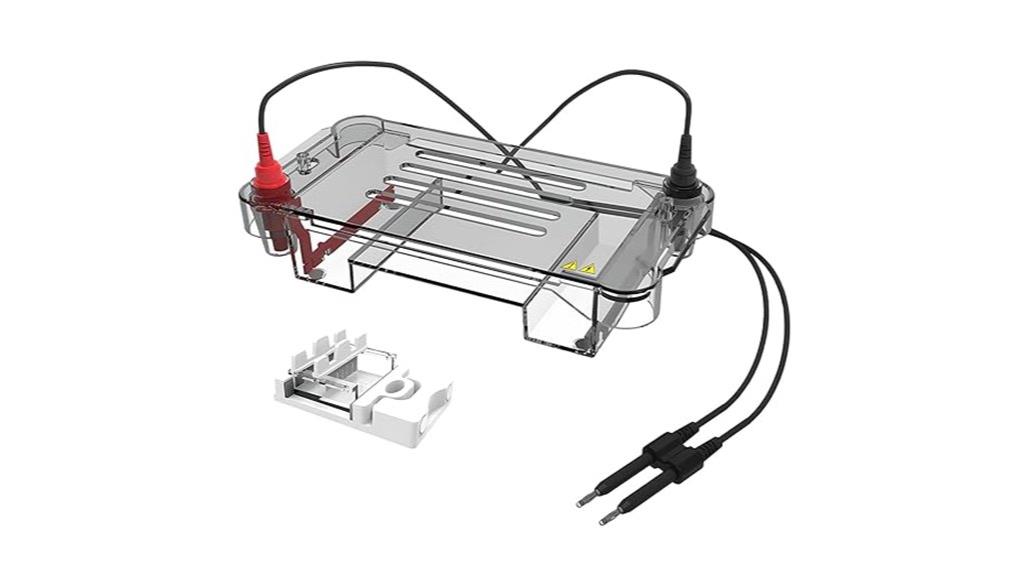
For researchers seeking precise and reliable DNA analysis, the Horizontal Electrophoresis Tank offers an ideal solution thanks to its durable polycarbonate construction and innovative heat dissipation system. Its 60×75mm gel capacity and 300mL buffer volume make it perfect for DNA and nucleic acid purification, separation, and identification. The tank’s leak-proof design and detachable platinum electrodes ensure consistent performance, safety, and easy maintenance. The heat dissipation system prevents condensation, maintaining stable conditions during electrophoresis. Overall, this tank simplifies gel handling, enhances accuracy, and boosts efficiency, making it an essential tool for modern molecular biology laboratories.
Best For: molecular biologists and laboratory technicians seeking reliable, efficient DNA analysis and nucleic acid purification solutions.
Pros:
- Durable polycarbonate construction ensures long-lasting, leak-proof use
- Innovative heat dissipation system maintains stable working conditions during electrophoresis
- Detachable platinum electrodes offer excellent conductivity and easy replacement
Cons:
- Gel capacity limited to 60×75mm, which may be small for large-scale experiments
- Requires careful handling to avoid damage to the electrodes and tank components
- The size and volume may not be suitable for high-throughput laboratory workflows
Vision Scientific VLE002P Electrophoresis Apparatus

If you’re seeking a reliable electrophoresis system capable of handling multiple samples simultaneously, the Vision Scientific VLE002P Electrophoresis Apparatus is an excellent choice. It supports 16 samples per gel, making it efficient for high-throughput testing. The device includes two versatile casting trays with embossed gel rulers, rubber end caps, and multiple slots for flexible comb placement. Its UV-transparent, leak-proof acrylic chamber ensures durability and safety during experiments. The system features locking electrodes, recessed wires, and a safety stop to prevent accidents. Plus, adjustable levelling feet provide stability, making setup straightforward and secure for accurate electrophoresis results.
Best For: researchers and laboratories needing reliable, high-throughput electrophoresis for analyzing multiple samples efficiently and safely.
Pros:
- Supports 16 samples per gel for high-throughput testing.
- Durable, leak-proof UV-transparent acrylic chamber ensures safety and longevity.
- Features locking electrodes, recessed wires, and safety stop for secure operation.
Cons:
- May require additional accessories or training for optimal use.
- The system’s size might be less suitable for very small laboratory spaces.
- Limited to electrophoresis applications; not adaptable for other laboratory procedures.
Parco Scientific Vertical Electrophoresis System
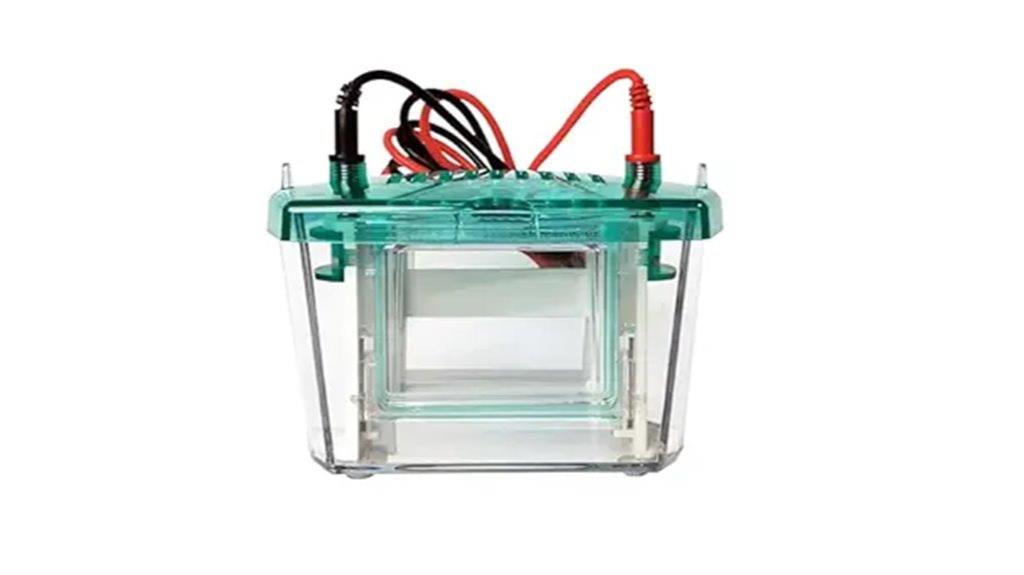
The Parco Scientific Vertical Electrophoresis System stands out as an ideal choice for laboratories seeking precise and efficient protein separation. Its integrated gel casting base prevents gel displacement during transfer, ensuring consistent results. The glass plates provide a uniform surface, resulting in reliable gel thickness and higher fit accuracy. Multiple anti-reverse features on transfer modules and tanks minimize polarity reversal and accidental falls, enhancing safety. Rust-proof electrode components boost durability, while using only 300mL of electrophoresis solution reduces reagent costs. Overall, this system offers stability, safety, and efficiency, making it perfect for research and diagnostic applications.
Best For: research and diagnostic laboratories seeking precise, efficient, and cost-effective protein separation solutions.
Pros:
- Integrated gel casting base prevents gel displacement, ensuring consistent results
- Uses only 300mL of electrophoresis solution, reducing reagent costs
- Rust-proof electrode components enhance durability and longevity
Cons:
- Limited to gel protein electrophoresis; not suitable for other electrophoresis applications
- May require training for optimal operation due to specialized design features
- The system’s size and setup might be less portable for field or on-site testing
Parco Scientific Transfer Electrophoresis System

The Parco Scientific Transfer Electrophoresis System stands out for its high transfer efficiency, making it ideal for labs needing quick, reliable protein or nucleic acid transfer. Its tank, made from high transparency polycarbonate, resists corrosion and offers clear visibility. The system features positive and negative transfer clip electrodes with handles, ensuring easy, precise connections. Transfer times range from 20 to 40 minutes, boosting workflow productivity. Its robust structure allows for seamless integration with ice bath cooling, preventing overheating and maintaining consistent results. Overall, this system combines efficiency, durability, and user-friendly operation, making it a valuable addition to modern electrophoresis laboratories.
Best For: laboratories requiring efficient, reliable, and quick transfer of proteins and nucleic acids during gel electrophoresis procedures.
Pros:
- High transfer efficiency with times ranging from 20 to 40 minutes, boosting productivity
- Durable tank made from corrosion-resistant, high-clarity polycarbonate for clear visibility and longevity
- Easy-to-use positive and negative transfer clip electrodes with handles for precise and safe connections
Cons:
- May require training for optimal operation due to specialized electrode connections
- Limited to gel and gel plate electrophoresis applications, not suitable for other electrophoresis types
- The system’s size and setup might be less portable for field or mobile lab use
Innovating Science Electrophoresis: Agarose Gel Separation of Dyes Kit
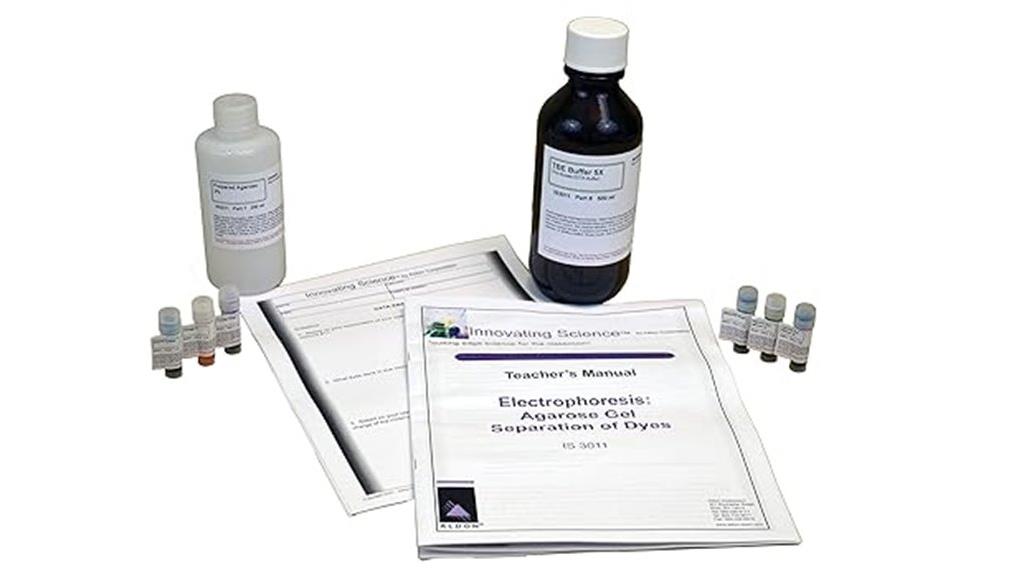
Designed for educators and students exploring molecular separation, the Innovating Science Electrophoresis: Agarose Gel Separation of Dyes Kit offers a hands-on way to visualize how molecules move through gel matrices. It includes agarose gel, buffer, dyes, a teacher’s manual, student study guides, and safety materials. The kit lets you run ten gels, demonstrating DNA or dye separation effectively. While it requires additional equipment like chambers, power supplies, and micropipettes, it’s perfect for classroom experiments in biology, chemistry, and physics. I find it invaluable for making complex concepts accessible and engaging, especially for students aged 13 and up.
Best For: educators and students aged 13+ seeking a practical, hands-on introduction to molecular separation techniques in biology, chemistry, and physics classrooms.
Pros:
- Facilitates visual understanding of electrophoresis and molecule movement through gels.
- Includes comprehensive materials like gels, buffers, dyes, and study guides to support learning.
- Encourages interdisciplinary STEM learning through engaging experiments.
Cons:
- Requires additional equipment such as electrophoresis chambers, power supplies, and micropipettes, which are sold separately.
- Limited to running ten gels, which may constrain larger class demonstrations.
- Safety precautions are necessary due to handling dyes and electrical equipment, requiring supervision.
Vision Scientific Transfer Electrophoresis System

If you’re looking for a reliable transfer electrophoresis system for protein and nucleic acid analysis, the Vision Scientific VS-EL-T1 stands out with its high transfer efficiency and durable construction. It features a corrosion-resistant polycarbonate tank and a transfer clip with distinct positive and negative electrodes for easy handling. The system’s size (70×90 mm) suits various applications, and its integrated cooling mechanism prevents overheating, ensuring consistent results. With a transfer time of 20-40 minutes and a buffer capacity of 500 ml, it offers both speed and reliability. Including all necessary components, it’s a practical choice for laboratories aiming for precision and efficiency.
Best For: researchers and laboratories seeking a durable, efficient transfer electrophoresis system for protein and nucleic acid analysis.
Pros:
- High transfer efficiency with quick processing times of 20-40 minutes
- Durable, corrosion-resistant polycarbonate tank for long-term use
- Integrated cooling mechanism prevents overheating, ensuring consistent results
Cons:
- Limited transfer size of 70×90 mm may not suit larger applications
- Requires a power supply up to 200 V, which may need specific electrical setups
- Shipping weight of 20 lbs could impact portability and handling
Benchmark Scientific E1101 Accuris MyGel Mini Electrophoresis System, 115V

For small laboratories, classrooms, or researchers seeking a portable and user-friendly electrophoresis system, the Benchmark Scientific E1101 Accuris MyGel Mini Electrophoresis System offers an ideal solution. Its compact design, measuring just 7 x 5.1 inches, makes it easy to set up and transport. The system includes everything needed for gel casting, with adjustable voltage settings, a built-in timer, and a vented safety lid for heat dissipation. Trays with contrast strips and fluorescence compatibility help monitor progress easily. While some users report occasional malfunctions, many appreciate its simplicity and portability, making it suitable for educational purposes and small-scale experiments.
Best For: small laboratories, educational settings, and researchers needing a portable, easy-to-use electrophoresis system for small-scale gel runs.
Pros:
- Compact and lightweight design measuring just 7 x 5.1 inches for easy transport and setup
- Includes all necessary components for gel casting and visualization with adjustable voltage and timer features
- User-friendly with quick gel casting and transparent safety lid for heat management
Cons:
- Occasional system malfunctions and error messages that may require troubleshooting
- Reports of frequent alarms and unstable operation, even out of the box
- Limited to small-scale applications; may not be suitable for high-throughput or large gel runs
Conductive Electrode Gel for TENS Unit Pads (8.9oz)
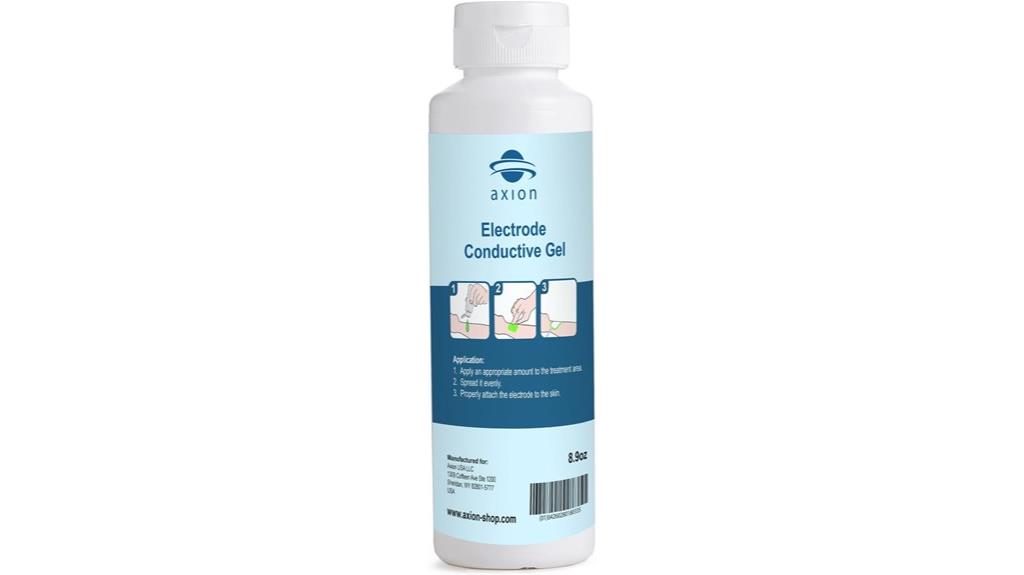
The Conductive Electrode Gel for TENS Unit Pads (8.9oz) is an excellent choice for anyone seeking to improve the effectiveness of their electrotherapy treatments. It enhances conductivity, ensuring better skin-to-electrode contact, which boosts treatment efficiency and comfort. The gel is formulated to be hypoallergenic, odorless, and non-greasy, making it safe for all skin types, including sensitive or hairy skin. Applying just a few drops creates a reliable, moist connection that prolongs electrode lifespan and reduces irritation. Its highly conductive aqueous solution minimizes resistance, helping devices perform *at their best*. Overall, this gel is a dependable accessory to maximize the benefits of TENS and other electrotherapy devices.
Best For: individuals using TENS, EMS, ultrasound, microcurrent, or electrotherapy devices seeking to improve electrode performance, comfort, and skin safety.
Pros:
- Enhances electrical conductivity for more effective treatments
- Hypoallergenic, odorless, and suitable for sensitive skin
- Extends electrode lifespan and improves adhesion
Cons:
- Slight fishy smell and sticky texture reported by some users
- Requires storage in a cool, dry place away from sunlight
- May need to reapply frequently during extended sessions
Vision Scientific VS-EL-V1 Vertical Electrophoresis System
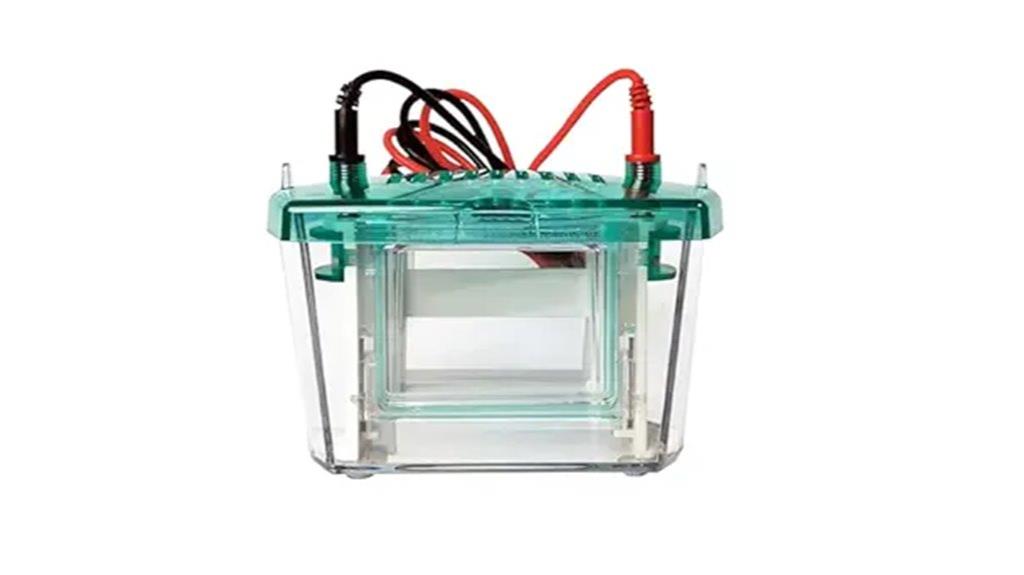
Designed to deliver precise and stable gel electrophoresis results, the Vision Scientific VS-EL-V1 Vertical Electrophoresis System stands out as an ideal choice for laboratories focused on protein and nucleic acid analysis. Its integrated gel casting base prevents displacement during gel transfer, ensuring stability. The glass plates offer uniform stress distribution and consistent gel thickness. Multiple anti-reverse safety features protect against reversing polarity, while rust-proof electrodes enhance durability. Requiring only 300mL of solution, it minimizes reagent use. Overall, this system combines efficiency, safety, and accuracy, making it a versatile tool for biological research, clinical diagnostics, and analytical chemistry.
Best For: laboratories conducting protein and nucleic acid analysis requiring stable, precise electrophoresis with safety features and reagent efficiency.
Pros:
- Integrated gel casting base ensures stability during gel transfer
- Uniform stress distribution and consistent gel thickness for reliable results
- Multiple anti-reverse safety features and rust-proof electrodes enhance durability and safety
Cons:
- Limited to gel sizes of 83x73mm, which may not suit larger sample needs
- Requires careful handling of glass plates to prevent breakage
- May have a learning curve for optimal use of accessories and sealing procedures
Factors to Consider When Choosing Gel Electrophoresis Systems
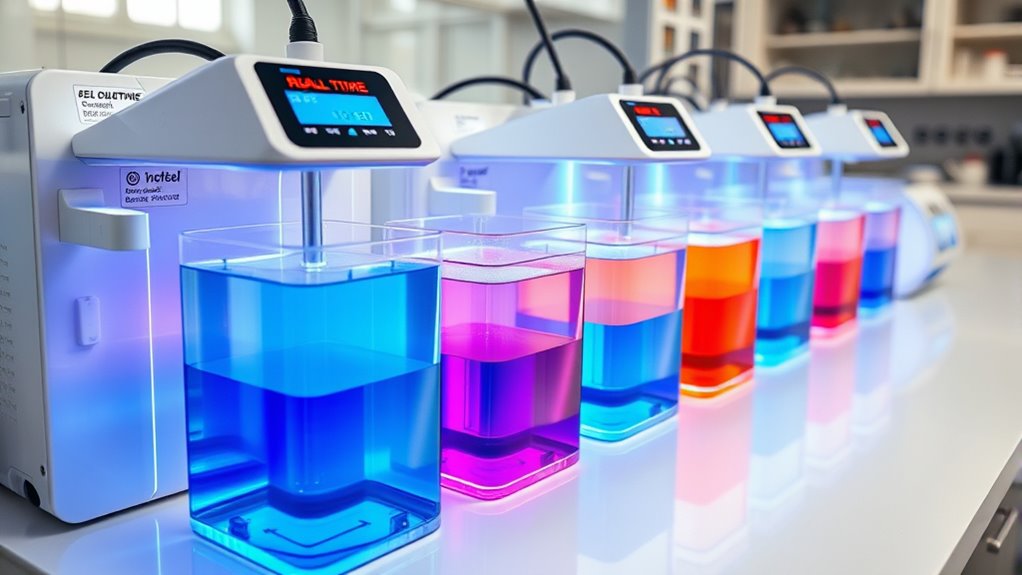
When selecting a gel electrophoresis system, I consider how well it matches my samples and the specific electrophoresis type I need. I also look for systems that are user-friendly and include safety features, while keeping reagent and buffer requirements in mind. These factors help make certain of reliable results and safe operation for my experiments.
Compatibility With Samples
Choosing the right gel electrophoresis system requires careful consideration of sample compatibility to guarantee efficient separation. I always verify that the system suits the size and type of my samples, whether DNA, RNA, or proteins, to assure optimal results. It’s essential to check if it can handle the volume and concentration I plan to use, along with the gel matrix type. I also confirm whether the system supports my preferred sample loading methods, like multi-channel pipettes or pre-cast gels. Additionally, I confirm the buffer and voltage ranges are appropriate for my samples, preventing degradation or incomplete separation. Finally, I evaluate if the electrode and chamber materials are compatible, especially for sensitive biological materials. Proper compatibility minimizes issues and boosts reproducibility.
Electrophoresis Type Needed
Selecting the appropriate electrophoresis system hinges on understanding the specific requirements of your samples. If you’re working with nucleic acids like DNA or RNA, a horizontal system is often ideal due to its ease in sample loading and gel casting with agarose gels. Conversely, for protein analysis, especially SDS-PAGE, vertical systems are preferred because they can accommodate diverse gel sizes and stacking configurations, enhancing resolution. Consider your sample’s size, charge, and whether you need denaturing or native conditions, as these factors influence the system choice. Additionally, think about how you’ll analyze the results afterward—whether through blotting, imaging, or other methods—as this impacts the compatibility of the electrophoresis type. Matching your system to your sample properties ensures suitable separation and analysis.
System Ease of Use
Ease of use is a key factor when choosing a gel electrophoresis system, as it directly impacts the efficiency and accuracy of your experiments. I look for systems with intuitive assembly, clear instructions, and straightforward operation steps to minimize setup time and user errors. Systems with pre-cast gels or integrated casting trays simplify preparation and save valuable time. Simple controls, like preset voltage and timers, make operation easy even for less experienced users. Detachable or transparent components facilitate cleaning and maintenance, ensuring hygiene and smooth workflow. User-friendly systems often feature visual indicators or safety features that help troubleshoot issues quickly and promote safe handling during experiments. Prioritizing ease of use ensures reliability and saves effort, especially during high-throughput or time-sensitive work.
Safety Features Included
Safety features are vital for protecting users and ensuring reliable operation during gel electrophoresis. I look for systems with safety stops that halt runs if the lid or cover isn’t secure, reducing electrical shock risks. Recessed electrical wires and protected electrode connections further minimize accidental disconnections and shocks. Locking mechanisms on electrodes and transfer clips ensure correct placement, preventing damage from reversing polarity. Leak-proof, corrosion-resistant materials like high-transparency polycarbonate contain buffers securely and prevent spills that could pose hazards. Additionally, adjustable leveling feet and stable designs help prevent tipping or shifting during runs. These safety features not only protect users but also maintain the integrity of experiments, making them a vital factor when selecting a gel electrophoresis system for precision and safety.
Reagent and Buffer Use
Choosing the right reagents and buffers is essential because they directly influence the accuracy and resolution of gel electrophoresis results. The buffer type, like TBE or TAE, affects ionic strength, pH stability, and buffering capacity, which are crucial for consistent separation. Reagents such as agarose or polyacrylamide determine the gel’s pore size, impacting how well DNA or proteins are resolved. Buffer composition also influences electrical conductivity; high-conductivity buffers can generate excess heat, so efficient cooling systems are necessary. Additionally, the purity and storage of buffers and reagents are vital to prevent contamination that can distort molecular weight estimation and band clarity. Proper preparation and handling ensure reproducibility, making reagent and buffer choices key to reliable electrophoretic results.
Visual Detection Methods
Selecting the appropriate visual detection method is essential for obtaining clear and accurate gel electrophoresis results. I look for systems that use safe illumination, like blue light transilluminators at around 470 nm, to visualize nucleic acid bands without UV exposure. Sensitivity is vital, so fluorescent dyes such as SYBR Green often outperform traditional dyes like bromophenol blue, enabling detection of even low-abundance samples. Digital imaging systems with integrated cameras and software improve result documentation, analysis, and record-keeping, making workflows more efficient. Some advanced systems feature LED illumination and transparent chambers, allowing real-time, non-destructive observation during electrophoresis. Ultimately, choosing a detection method that balances safety, sensitivity, and ease of analysis guarantees reliable and precise results in my experiments.
System Durability and Material
When evaluating gel electrophoresis systems, the materials used in construction play a crucial role in guaranteeing long-term durability. High-quality materials like polycarbonate or acrylic resist cracking and chemical corrosion, extending the system’s lifespan. The choice of material also affects resistance to thermal stress; heat-dissipating components prevent warping during extended runs. Using anti-aging materials in electrodes, tanks, and other parts reduces the need for frequent replacements. Leak-proof construction, achieved through injection-molded plastics or sealed joints, enhances overall integrity and safety. Additionally, corrosion-resistant and rust-proof materials in electrodes and transfer clips ensure consistent performance over time, even with repeated exposure to buffers and reagents. Prioritizing durable, high-quality materials leads to a reliable, long-lasting electrophoresis system.
Budget and Cost Effectiveness
Evaluating the budget and cost-effectiveness of gel electrophoresis systems is essential to making a smart investment. I look at the initial purchase price and ongoing costs like replacement electrodes, gels, buffers, and maintenance supplies to gauge overall affordability. I also consider how efficiently the system uses reagents and samples, as economical models can reduce per-experiment expenses. Durability and build quality matter because they influence long-term use and lower repair costs. I compare energy consumption, since energy-efficient units can save money over time. Additionally, I assess the availability and cost of compatible accessories and consumables, as limited or pricey options can increase the total cost of ownership. Balancing upfront costs with operational savings helps me choose the best system for my needs.
Frequently Asked Questions
What Are the Latest Technological Advancements in Gel Electrophoresis Systems?
The latest advancements in gel electrophoresis systems include high-resolution imaging, automated sample loading, and miniaturized devices that save time and reduce errors. I’ve noticed improvements in mobility and sensitivity, thanks to innovative dyes and detection methods. Additionally, integration with digital analysis software has made data interpretation faster and more accurate. These upgrades help me achieve precise results efficiently, making my work in molecular biology much more streamlined.
How Do Safety Features Vary Across Different Electrophoresis Models?
Safety features vary across electrophoresis models, and I always look for systems with built-in safeguards. Some models include automatic shut-off when overheating, protective covers to prevent accidental contact with electric fields, and leak-proof components. Others offer real-time monitoring and emergency stop functions. I find that choosing a system with thorough safety features not only protects me but also ensures the accuracy and reliability of my experiments.
What Are the Maintenance Requirements for High-Precision Electrophoresis Systems?
Maintaining high-precision electrophoresis systems keeps them running smoothly and guarantees accurate results. I regularly clean the gel trays and replace worn-out buffer solutions to prevent contamination. Calibration checks are essential, and I schedule routine inspections for the power supplies and cooling systems. Skipping these steps risks equipment failure and compromised data, so I stay vigilant. Proper maintenance isn’t just routine; it’s the key to consistent, reliable experiments.
How Does Software Integration Enhance Electrophoresis Accuracy?
Software integration considerably enhances electrophoresis accuracy by providing real-time control and precise adjustments during runs. I love how it automates parameters, reducing human error and ensuring consistent results. With advanced software, I can analyze data instantly, identify issues early, and optimize protocols for better outcomes. It’s like having a virtual assistant that fine-tunes every step, making my experiments more reliable, efficient, and reproducible every time.
What Environmental Considerations Impact Electrophoresis System Selection?
You might think the environment doesn’t matter, but it actually plays a huge role. Humidity, temperature fluctuations, and vibration can all throw off your results. I’ve learned this the hard way. When selecting an electrophoresis system, I prioritize climate control features and sturdy construction to guarantee consistent, accurate outcomes. Ignoring environmental factors is like ignoring the weather—sure, until it ruins your experiment.
Conclusion
Choosing the right gel electrophoresis system can dramatically boost your lab’s precision and efficiency. Did you know that labs using advanced systems like the PLEXUS MegaX® report up to 30% faster results? With so many options tailored for different needs, understanding your specific requirements is key. Investing in the right system not only saves time but also guarantees reliable, high-quality data—making your research more accurate and impactful.


